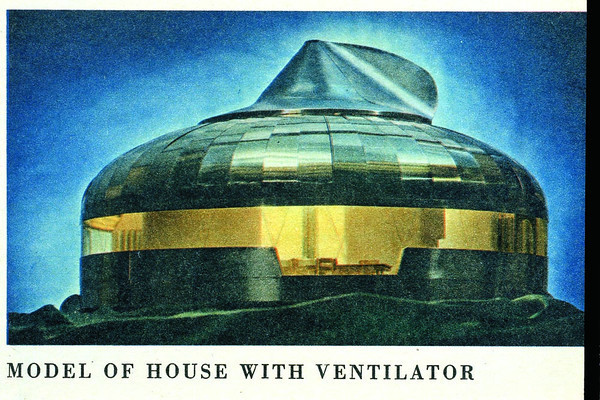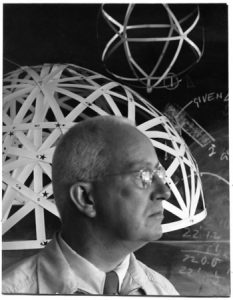
Lesson Plans for Spaceship Earth

No stranger to generating new ideas, Buckminster Fuller 1913 left a lasting legacy of human ingenuity.
Story by Steve Nadis
In 1966, a New Yorker article described R. Buckminster (“Bucky”) Fuller 1913—one of Milton’s most famous graduates—as “an engineer, inventor, mathematician, architect, cartographer, philosopher, cosmogonist, and comprehensive designer.” An internationally renowned figure who wrote 28 books, held 28 patents, and earned 47 honorary doctoral degrees, Fuller offered a more succinct autobiographical description, calling himself “the world’s most successful failure.”
He might have said that because his most grandiose schemes never reached fruition—or at least not nearly on the scale he envisioned. In a career that spanned almost 70 years, Fuller concocted some pretty far-fetched notions that were, at a minimum, ahead of their time. They included flying cars; a city of a million inhabitants afloat in Tokyo Bay; a hemispherical dome two miles in diameter that would enclose central Manhattan, converting it into a climate-controlled paradise; communities built within giant craters that could house 25,000 families; fully submerged cities, anchored at sea, with delivery service provided by submarines; and, perhaps wackiest of all, floating cities, encased within balloon-like structures that would be so light, Fuller said, “they can be delivered by air.”
 The fact that these propositions never got off the ground—or underground or under water—did not slow Fuller down, because he had no trouble generating ideas. Although he lived, and fully embodied, the “life of the mind,” he was no ivory tower thinker. He applied his powers of cognition to practical problems—involving food, energy, shelter, and transportation—and he was convinced that human resourcefulness could, ironically, solve problems of poverty and hunger that were commonly ascribed to resource scarcity. As he once said, “We don’t have an energy crisis. We just have a crisis of ignorance.”
The fact that these propositions never got off the ground—or underground or under water—did not slow Fuller down, because he had no trouble generating ideas. Although he lived, and fully embodied, the “life of the mind,” he was no ivory tower thinker. He applied his powers of cognition to practical problems—involving food, energy, shelter, and transportation—and he was convinced that human resourcefulness could, ironically, solve problems of poverty and hunger that were commonly ascribed to resource scarcity. As he once said, “We don’t have an energy crisis. We just have a crisis of ignorance.”
The world’s greatest resource, he added, was not water, fossil fuels, mineral wealth, or abundant vegetation. It was human intelligence, ingenuity, and imagination. On that score, he surely contributed his fair share.
Fuller showed his promise early on, when his kindergarten teacher asked her students to make some- thing out of toothpicks and dried peas. Young Bucky created an elaborate yet stable structure of interlocking triangles known as an “octet truss.” In 1961, around 60 years later, Fuller patented that design. He may not have considered his kindergarten feat particularly impressive, because he later remarked, “All children are born geniuses, and we spend the first six years of their lives degeniusing them.”
In 1904, at the age of nine—and by then, presumably, thoroughly “degeniused”—Fuller entered Milton Academy, where he would continue as a day student until his graduation in 1913. He claimed to have learned everything he needed for his subsequent engineering efforts from his Milton physics classes. He professed his debt to the academy in an inscribed photo that still hangs in the school’s admissions office: “To: Wonderful Milton Academy, where I learned how to organize thought and was urged to ‘Dare to be true’ to what I learned from organized thoughts.”
He was admitted to Harvard, but the experience did not go smoothly. After matriculating in 1913, he was expelled in 1914 and again in 1915— the second time for good. That ended his formal undergraduate training but marked the beginning of a lifelong, self-guided educational process. He also gained some valuable experience in the school of hard knocks, starting with his first job that same year for the meat-packing firm Armour and Company, in New York City, where he worked six days a week from 3 a.m. to 6 p.m.
Fuller served in the U.S. Navy Reserve from 1917 to 1919, during World War I. He left his position at Armour in 1921 and took a job with a truck company until he was let go, a year later. He then struck out on his own as a would-be entrepreneur, but things did not go well. In 1927, he found himself 32 years old, unemployed, and broke, with a wife and a newborn daughter to support. He came close to committing suicide in the icy waters of Lake Michigan before an epiphany struck that set his life onto a new trajectory. If he committed suicide, he realized, “the inventory of knowledge that I had accrued would also be forever lost—an inventory of information that … might prove to be of critical advantage to others.” Henceforth, he vowed, his life would be “an experiment to find what a single individual can contribute to changing the world and benefiting all humanity.”
For more than a year, Fuller lived with his wife and daughter in the slums of Chicago, barely talking and instead immersing himself in reading and thought, filling notebooks with 2,000 pages of ideas that he hoped would propel him toward his newfound goals.
He started with a novel approach to home building. In his constructions, stability would be achieved not only by piling materials on top of a foundation and then on one another, but also through the “tensional forces” provided by cables or, say, the surface of a pressurized balloon. These elements came together in 1929 when he unveiled a model of the 4D House, subsequently renamed the Dymaxion House. (“Dymaxion” is a contraction of dynamic, maximum, and tension—three words that Fuller was fond of—and he applied it to many subsequent endeavors.) Shaped like a pentagon, with windows on all sides, the Dymaxion House would be made out of metal and suspended from a central mast on steel cables. The home was intended to be transportable, and “airliftable,” to other sites. Ultimately, just one Dymaxion House was ever built—a dwelling in Wichita, Kansas, in 1946.
The first prototype of a Dymaxion Car appeared in 1933. It was a lightweight, three-wheeled vehicle, shaped like a blimp, that had a periscope in place of a rear window. The original version could seat 11 people and attain speeds of 120 miles per hour. Fuller later changed his design to a five-seater, but neither version was ever manufactured commercially.
Altogether, 13 models of the Dymaxion Bathroom were assembled. Each was a self-contained, prefabricated unit including a sink, a toilet, and a bath that in theory could be installed as easily as a refrigerator. But production was terminated in 1936. Fuller had many gifts—and was widely heralded as a genius— but marketing was never his strong suit.
He had better luck with the geodesic dome—a spherical structure whose surface, like that of a soccer ball, is composed of flat polygons. The sphere appealed to Fuller because it has the largest volume-to-surface ratio of all three-dimensional objects and therefore could encapsulate more space with fewer materials. Another virtue of this design was that a frame’s strength automatically increased with size. With help from students, Fuller built his first geodesic dome in 1948 at Black Mountain College, using the only materials then available—metal strips from Venetian blinds. But the strips were too flimsy, and the dome, which was 48-feet in diameter, immediately collapsed. Fuller, however, took its demise in stride, saying, “You succeed when you stop failing.”
Sure enough, the failure did stop: An estimated 300,000 domes have since been built—ranging from small playground structures to the 250-foot-wide U.S. pavilion at the 1967 World’s Fair in Montreal.
In 1969, Fuller published a book that popularized the term “Spaceship Earth.” Those two words conveyed a potent image that changed the way many people viewed the world. If Earth truly is like a spaceship, then all the passengers have to work together to keep it running properly. “We are all astronauts,” Fuller proclaimed in a clarion call that promoted sustainable living practices, while simultaneously giving a boost to a burgeoning environmental movement.
Fuller didn’t lament the fact that some of his wilder ideas, such as floating cities (“Cloud Nines,” as he called them), wouldn’t be built anytime soon, if ever. He still considered them an “exercise to stimulate imaginative thinking,” and in his view, there could be no loftier objective. If one could unlock the power of creative thought and direct that toward the common good, anything might be possible. His remarkable life story was—and continues to be—a testament to that fact.
Steve Nadis is a freelance science writer based in Cambridge, Massachusetts. He’s a contributing editor for Discover and a contributing writer for Quanta; his articles have appeared in dozens of other magazines.




